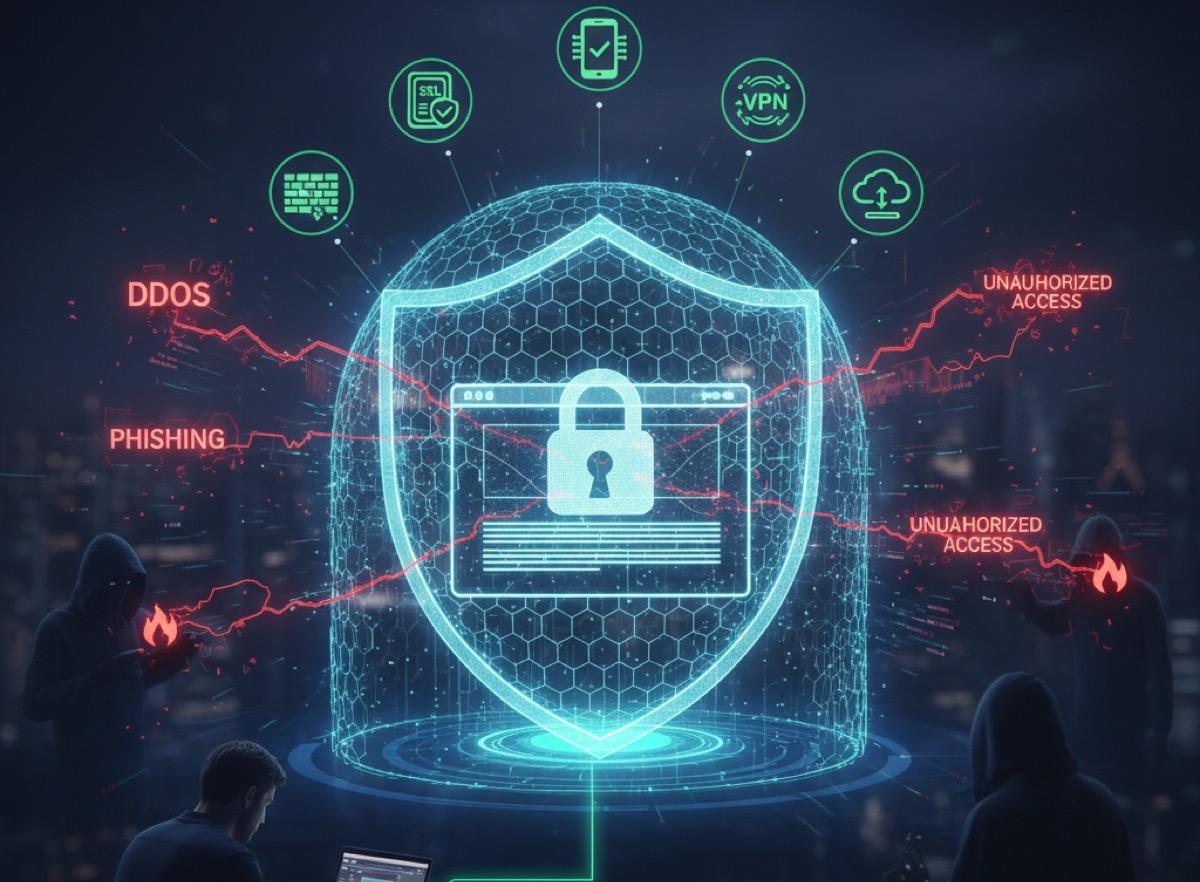Web hosting is a world full of opportunities, regardless of your goal. Whether you want to build your first landing page for a startup, create a blog to earn passive income, or make an impressive portfolio for potential clients, your website can be the first step to success. But what if someone breaks in and steals all your hard work?
To avoid that, you should prioritize security when working with web hosting. In this article, we will outline common threats you should be aware of, essential tools to protect your site, and additional tips for managing your website effectively. Let’s make your web hosting experience flawless!
Common Web Hosting Threats
Cybersecurity is essential when creating websites, as many bad actors constantly threaten to crash the server, steal personal information, or even take over the URL altogether. Here are the issues most online users face.
DDoS (Distributed Denial of Service) Attacks
The goal of the DDoS attack is to overwhelm the website and make it completely unusable. While many users think that bad actors target only popular URLs, beginner websites are also in danger. If you find that any of your new web pages rise in popularity, or your cybersecurity skills are weak, hackers crashing the server shouldn’t be a surprise.
Malware
In case you use illegal programs or compromised plugins, you can spread malicious software to your website through the hosting. Once that happens, your website is no longer safe to use, as it can continue spreading to visitors, start stealing data, and even infiltrate your personal devices.
Phishing
Many hackers try to trick people into thinking that they are a real brand, platform, or trusted representative to get a hold of their sensitive data. Phishing usually happens through fake emails, messages, calls, and even login pages. Sometimes, it’s very hard to see the difference between a real and spoofed page.
Unauthorized Access
Newbies often manage their first websites irresponsibly due to a lack of knowledge of web hosting. Simple and short passwords, unprotected portals, unsecured mobile connections, and other factors can also lead to unauthorized access to a website, leading to data theft and loss of credentials.
Set Up the Standard Layer of Defense
The first step to avoid common web hosting dangers is to set up SSL, or Secure Sockets Layer, on your website. SSL acts as a shield between you and the website visitor by encrypting the information transferred between the two. That means that all the data the visitor sends and receives is unreadable to unauthorized users, such as hackers, and they won’t be able to steal sensitive info from your server.
SSL is a standard option for all safe websites, so make sure to use it on all pages. Additionally, check that your website always loads over HTTPS. This option is free for all users exploring web hosting.
Protect Your Mobile Connection
Website owners no longer have to be stuck at home in front of their computers; they can freely manage their hosting on the go, whether while exploring new coffee shops in town or even traveling overseas. Using your standard SIM card to do so might not be the safest, though.
eSIMs, however, are built into your device and encrypted, allowing for a safe connection. Unlike removable SIM cards, they can’t be swapped or compromised by an attacker to get access to your websites or credentials, either. When preparing to travel internationally, like planning a business trip or vacation in Asia, researching the best eSIM for Thailand (or your destination) is a crucial security step to ensure your connection remains protected while managing your vital hosting credentials.
Reinforce With Firewalls
Utilizing firewalls is another step in web hosting protection. Firewalls help users identify harmful requests and malware and then block them to prevent unauthorized access and website crashes. When looking for a hosting service, ask the representatives if they offer WAFs, or web application firewalls, as part of the service. Additionally, look for other safety plugins for your CMS to reinforce the safety of your website and avoid common threats.
Ensure Easy Recovery With Backups
Your website and database might be safeguarded entirely, but failures and malware can still affect them. Always prepare backups to preserve the data and ensure easy recovery. Schedule them daily or weekly and save them to an external hard drive or cloud storage. That way, it won’t be erased by hackers from your device. Once backed up, try it by running a test recovery.
Encrypt Your Remote Access
When you manage your hosting remotely and want even more reassurance that your website stays safe, use VPN software on all your devices. If you’re not familiar what a VPN is, it’s short for Virtual Private Network, which serves as another shield between your device and the hosting provider, encrypting the traffic you send and receive.
Furthermore, connecting to a public Wi-Fi shields your data from bad actors spying on users through an open network. With a VPN on, they won’t be able to steal your sensitive information. That said, a VPN protects devices from common web hosting threats, too, by blocking man-in-the-middle attacks, redirects, and other malicious actions.
Aiming for More Protection?
The steps above are just the basics of online safety during web hosting. If you want even more protection for your website, data, and devices, we have prepared additional helpful tips beyond SSL, eSIMs, and backups:
- Use unique, long, and complex passwords to lock your devices and accounts. Passcodes such as the date of your birth, the word “password”, or numbers from 1 to 10 are all overused. Aim for at least 12 characters and use numbers, special characters, lowercase, and uppercase letters in your combination.
- Keep all your software updated, no matter what. Most updates come out as a response to new safety concerns, and can be a great way to shield your website from malicious actions.
- Turn on two-factor authentication on your hosting control panel, CMS logins, and any other accounts you deem fit. 2FA ensures that whoever wants to log in has to have access to either your phone or email.
- Once your plugins or firewalls are installed, program them to block repeated failed login attempts so password guessing is impossible for hackers.
- Monitor possible emerging security threats online to always know what’s coming. Being informed means being protected, as you will be able to adapt your strategy to potential attacks and prevent strangers from breaking into your new website.
These tips will make your first web hosting experience even safer. Bad actors will not have a chance to steal your credentials or overwhelm your server.
Cast a Safety Net Over Your Web Hosting
Web hosting might seem like a complicated skill to learn, especially when it comes to security. Hackers are always there, snooping on unsecured connections, stealing sensitive data, and attacking vulnerable websites. Yet, it doesn’t have to be this daunting.
Taking basic security steps will put you way ahead of bad actors. You can start by using simple SSL to set a standard shield between your website and hackers online. Using eSIMs and VPNs when managing your hosting remotely is another great way to ensure no one can spy on your online activity, as everything will be encrypted. Firewalls and backups, too, enhance your protection. Even if something goes wrong, you can always recover your website and server. All these cast a safety net over your brand-new website.


